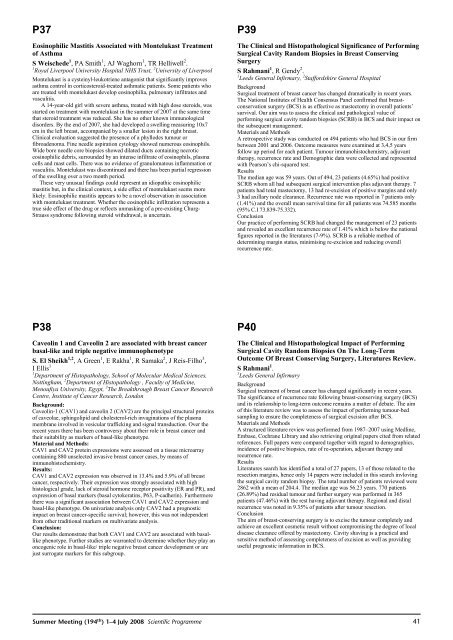2008 Summer Meeting - Leeds - The Pathological Society of Great ...
2008 Summer Meeting - Leeds - The Pathological Society of Great ...
2008 Summer Meeting - Leeds - The Pathological Society of Great ...
Create successful ePaper yourself
Turn your PDF publications into a flip-book with our unique Google optimized e-Paper software.
P37Eosinophilic Mastitis Associated with Montelukast Treatment<strong>of</strong> AsthmaS Weischede 1 , PA Smith 1 ,AJ Waghorn 1 , TR Helliwell 2 .1 Royal Liverpool University Hospital NHS Trust, 2 University <strong>of</strong> LiverpoolMontelukast is a cysteinyl-leukotriene antagonist that significantly improvesasthma control in corticosteroid-treated asthmatic patients. Some patients whoare treated with montelukast develop eosinophilia, pulmonary infiltrates andvasculitis.A 14-year-old girl with severe asthma, treated with high dose steroids, wasstarted on treatment with montelukast in the summer <strong>of</strong> 2007 at the same timethat steroid treatment was reduced. She has no other known immunologicaldisorders. By the end <strong>of</strong> 2007, she had developed a swelling measuring 10x7cm in the left breast, accompanied by a smaller lesion in the right breast.Clinical evaluation suggested the presence <strong>of</strong> a phyllodes tumour orfibroadenoma. Fine needle aspiration cytology showed numerous eosinophils.Wide bore needle core biopsies showed dilated ducts containing necroticeosinophilic debris, surrounded by an intense infiltrate <strong>of</strong> eosinophils, plasmacells and mast cells. <strong>The</strong>re was no evidence <strong>of</strong> granulomatous inflammation orvasculitis. Montelukast was discontinued and there has been partial regression<strong>of</strong> the swelling over a two month period.<strong>The</strong>se very unusual findings could represent an idiopathic eosinophilicmastitis but, in the clinical context, a side effect <strong>of</strong> montelukast seems morelikely. Eosinophilic mastitis appears to be a novel observation in associationwith montelukast treatment. Whether the eosinophilic infiltration represents atrue side effect <strong>of</strong> the drug or reflects unmasking <strong>of</strong> a pre-existing Churg-Strauss syndrome following steroid withdrawal, is uncertain.P39<strong>The</strong> Clinical and Histopathological Significance <strong>of</strong> PerformingSurgical Cavity Random Biopsies in Breast ConservingSurgerySRahmani 1 ,RGendy 2 .1 <strong>Leeds</strong> General Infirmary, 2 Staffordshire General HospitalBackgroundSurgical treatment <strong>of</strong> breast cancer has changed dramatically in recent years.<strong>The</strong> National Institutes <strong>of</strong> Health Consensus Panel confirmed that breastconservationsurgery (BCS) is as effective as mastectomy in overall patients’survival. Our aim was to assess the clinical and pathological value <strong>of</strong>performing surgical cavity random biopsies (SCRB) in BCS and their impact onthe subsequent management.Materials and MethodsA retrospective study was conducted on 494 patients who had BCS in our firmbetween 2001 and 2006. Outcome measures were examined at 3,4,5 yearsfollow up period for each patient. Tumour immunohistochemistry, adjuvanttherapy, recurrence rate and Demographic data were collected and representedwith Pearson’s chi-squared test.Results<strong>The</strong> median age was 59 years. Out <strong>of</strong> 494, 23 patients (4.65%) had positiveSCRB whom all had subsequent surgical intervention plus adjuvant therapy. 7patients had total mastectomy, 13 had re-excision <strong>of</strong> positive margins and only3 had axillary node clearance. Recurrence rate was reported in 7 patients only(1.41%) and the overall mean survival time for all patients was 74.585 months(95% C.I 73.839-75.332).ConclusionOur practice <strong>of</strong> performing SCRB had changed the management <strong>of</strong> 23 patientsand revealed an excellent recurrence rate <strong>of</strong> 1.41% which is below the nationalfigures reported in the literatures (7-9%). SCRB is a reliable method <strong>of</strong>determining margin status, minimising re-excision and reducing overallrecurrence rate.P38Caveolin 1 and Caveolin 2 are associated with breast cancerbasal-like and triple negative immunophenotypeS. El Sheikh 1,2 , A Green 1 ,ERakha 1 , R Samaka 2 , J Reis-Filho 3 ,I Ellis 11 Department <strong>of</strong> Histopathology, School <strong>of</strong> Molecular Medical Sciences,Nottingham, 2 Department <strong>of</strong> Histopathology , Faculty <strong>of</strong> Medicine,Menoufiya University, Egypt, 3 <strong>The</strong> Breakthrough Breast Cancer ResearchCentre, Institute <strong>of</strong> Cancer Research, LondonBackground:Caveolin-1 (CAV1) and caveolin 2 (CAV2) are the principal structural proteins<strong>of</strong> caveolae, sphingolipid and cholesterol-rich invaginations <strong>of</strong> the plasmamembrane involved in vesicular trafficking and signal transduction. Over therecent years there has been controversy about their role in breast cancer andtheir suitability as markers <strong>of</strong> basal-like phenotype.Material and Methods:CAV1 and CAV2 protein expressions were assessed on a tissue microarraycontaining 880 unselected invasive breast cancer cases, by means <strong>of</strong>immunohistochemistry.Results:CAV1 and CAV2 expression was observed in 13.4% and 5.9% <strong>of</strong> all breastcancer, respectively. <strong>The</strong>ir expression was strongly associated with highhistological grade, lack <strong>of</strong> steroid hormone receptor positivity (ER and PR), andexpression <strong>of</strong> basal markers (basal cytokeratins, P63, P-cadherin). Furthermorethere was a significant association between CAV1 and CAV2 expression andbasal-like phenotype. On univariate analysis only CAV2 had a prognosticimpact on breast cancer-specific survival; however, this was not independentfrom other traditional markers on multivariate analysis.Conclusion:Our results demonstrate that both CAV1 and CAV2 are associated with basallikephenotype. Further studies are warranted to determine whether they play anoncogenic role in basal-like/ triple negative breast cancer development or arejust surrogate markers for this subgroup.P40<strong>The</strong> Clinical and Histopathological Impact <strong>of</strong> PerformingSurgical Cavity Random Biopsies On <strong>The</strong> Long-TermOutcome Of Breast Conserving Surgery, Literatures Review.SRahmani 1 .1 <strong>Leeds</strong> General InfirmaryBackgroundSurgical treatment <strong>of</strong> breast cancer has changed significantly in recent years.<strong>The</strong> significance <strong>of</strong> recurrence rate following breast-conserving surgery (BCS)and its relationship to long-term outcome remains a matter <strong>of</strong> debate. <strong>The</strong> aim<strong>of</strong> this literature review was to assess the impact <strong>of</strong> performing tumour-bedsampling to ensure the completeness <strong>of</strong> surgical excision after BCS.Materials and MethodsA structured literature review was performed from 1987–2007 using Medline,Embase, Cochrane Library and also retrieving original papers cited from relatedreferences. Full papers were compared together with regard to demographics,incidence <strong>of</strong> positive biopsies, rate <strong>of</strong> re-operation, adjuvant therapy andrecurrence rate.ResultsLiteratures search has identified a total <strong>of</strong> 27 papers, 13 <strong>of</strong> those related to theresection margins, hence only 14 papers were included in this search invlovingthe surgical cavity random biopsy. <strong>The</strong> total number <strong>of</strong> patients reviewed were2862 with a mean <strong>of</strong> 204.4. <strong>The</strong> median age was 56.23 years. 770 patients(26.89%) had residual tumour and further surgery was performed in 365patients (47.46%) with the rest having adjuvant therapy. Regional and distalrecurrence was noted in 9.35% <strong>of</strong> patients after tumour resection.Conclusion<strong>The</strong> aim <strong>of</strong> breast-conserving surgery is to excise the tumour completely andachieve an excellent cosmetic result without compromising the degree <strong>of</strong> localdisease clearance <strong>of</strong>fered by mastectomy. Cavity shaving is a practical andsensitive method <strong>of</strong> assessing completeness <strong>of</strong> excision as well as providinguseful prognostic information in BCS.<strong>Summer</strong> <strong>Meeting</strong> (194 th ) 1–4 July <strong>2008</strong> Scientific Programme41













